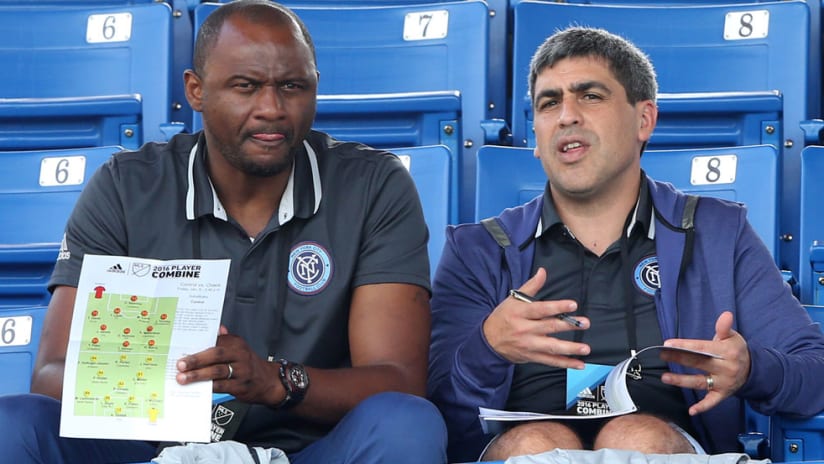LAUDERHILL, Fla. – The matches get most of the attention, but the most important moments of the 2016 adidas MLS Player Combine may just take place back at the hotel.
That’s where clubs and players sit down for their pre-SuperDraft interviews, and, in some cases, it’s where draft decisions are made.
All 20 MLS clubs interview Combine participants, with many teams meeting with a vast majority of the prospects assembled in South Florida. Clubs have varied approaches to the interview process. Some teams have their entire technical staff sit down with prospects, while others limit the size of their group to two or three people. Some clubs have a set script of questions, and other teams aim for more of a free-flowing, organic discussion.
Regardless of their methods, every team is aiming for the same thing: A better sense of who a player is, how he thinks, how he carries himself and, perhaps most importantly, how he might fit in with their locker room.
“They’re very important, you put a lot of weight on them,” Philadelphia Union head coach Jim Curtin told MLSsoccer.com. “But I think it’s the hardest thing to judge, it’s the hardest thing to judge the player’s heart and their mind. It’s a 10-15 minute opportunity to do that, and you want to take advantage of it.”
Just how do teams pull that off? Some start by asking players about their family and hometown, with the idea that valuable details will emerge when a player talks about his background.
“I ask everybody about their family, I ask everybody about mom, dad, brother, sister. I think if you’re talking about your family, that’s really basic and that informs,” said Seattle Sounders general manager and president of soccer Garth Lagerwey. “I ask them where they’re from, I mean we already know that, but having someone talk about themselves and where they’re from I think is both very interesting and very informative in terms of their world view and their cultural values, and we know our group and we can kind of see how it fits.”
In addition to digging for info on a player’s work ethic, leadership and general personality, Curtin and the Union always make it a point to ask a prospect about his knowledge of MLS.
“I ask if they follow MLS, are they a guy who’s dialed in to what the heck they’re getting into,” he said. “You’d be shocked how many kids don’t watch the league. For me, that’s kind of a little bit of a turnoff. You’re here at a Combine for MLS, you should know the players in the league, the players at the position you play, who you’re going to be competing with. If you have no idea who plays center midfield for the Philadelphia Union and you’ve never heard of Mo Edu, it puts up a little bit of, not of a red flag, but it’s something that you weigh in.”

Philadelphia Union manager Jim Curtin
Most teams make sure to include a little bit about themselves in their meetings. After all, interviews are a two-way street. Clubs don’t just want to leave a meeting impressed with a player; they want the player to be impressed with them, too.
“We feel strongly about any time someone interacts with us, whether it’s at our training facility, at our stadium, comes to visit our staff and our team, we want them to walk away with a feeling that Red Bulls are trying to do things the right way,” said New York head coach Jesse Marsch. “So we have a little video presentation; we’ll show them a little bit about what we’re about, who we are, how we play, that’s the first part that we try to achieve in our interviews. Ideally, we want to have each guy walk away going, ‘Man, it’d be great to play for the Red Bulls.'”
It’s rare for a team to completely remove anyone from their draft board based on a Combine chat, but it does happen. Lagerwey said he’s failed about five players during his years as a GM for bringing up various “problems that aren’t worth managing” during a meeting, while Marsch and Curtin both lamented players coming across as too “fake” in sit downs.
- Stock Up / Stock Down: Who's rising and falling on draft board
Of course, players are coached up for their interviews, and most can come across well enough in one relatively short meeting. The best interviewees do more than just that, however. The standouts form a connection with a club, giving real, substantive answers instead of canned, prepared responses.
“I remember being very impressed with [former Sounders midfielder] Andy Rose,” Marsch said. “He was just genuine and real, that’s what I’m looking for. You want somebody that’s going to be a regular guy and just come in and give everything he has, work really hard, want to be part of something and want to give what he has every day.”
“You want them to be as comfortable as possible, you don’t want them to be fake in their interviews, but it’s an art to try to draw it out of them,” added Curtin. “For a 20-year-old kid to walk into a room full of six, seven people, coaches and GMs, it’s intimidating. It’s not easy to go through, but it’s something that I think is beneficial for them, and I think it’s beneficial for us.”










